White birds with long beaks tend to live near bodies of water. The long bill helps them to catch fish and other kinds of aquatic prey. It’s also possible that their white feathers make them hard for their prey to see. Here are nine plus birds with white feathers and long beaks.
Egrets
1. Snowy Egret
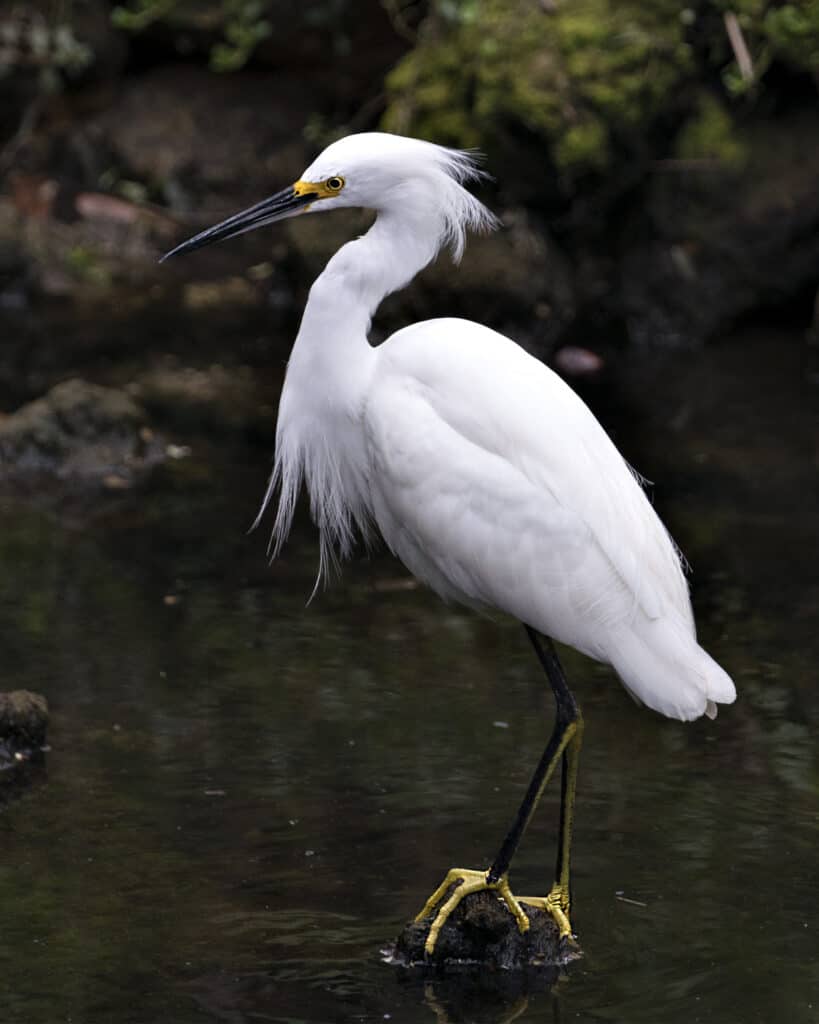
The snowy egret is one of the most beautiful of the white birds with long beaks.
©iStock.com/Rejean Bedard
The beautiful shorebird, Egretta thula, is native to the Americas and the Caribbean. You’ll find it near shallow bodies of water such as mangroves, saltwater marshes, and lagoons. Most of these birds are 22 to 26 inches long, have a 39-inch wingspan, and weigh between 11 and 13 ounces. Males are a bit larger than females.
The snowy egret sports pure white feathers, yellow eyes and feet, a long black bill, and long black legs. During the breeding season the feet change from yellow to orange and the adults grow beautiful, airy plumes from their breasts. During the Victorian and Edwardian eras these plumes were worth more than gold, and the bird used to be hunted for them. However, since 1916 snowy egrets have been protected through the Migratory Bird Treaty Act. They still are under threat from pollution and habitat destruction, even though their conservation status is least concern as of 2023.
A related egret, E. garzetta is called the little egret, even though it’s larger and heavier than the snowy egret! Additionally, its legs, neck, and bill are longer. A juvenile little blue heron might also be mistaken for a snowy egret, though these birds turn dark blue when they’re adults.
2. Cattle Egret
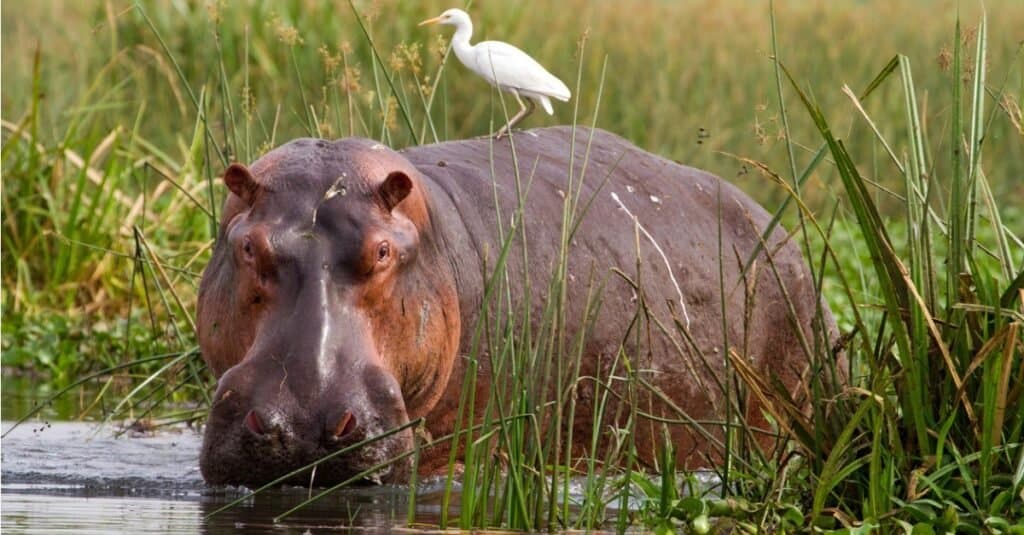
Cattle egrets often hitch rides on larger animals but not because they’re looking for ticks.
©iStock.com/PB_Images
The cattle egret isn’t that closely related to the snowy egret, as its scientific name is Bubulcus ibis. Though native to the south of Spain and Africa, the cattle egret is now found basically all over the world. It’s not as tied to bodies of water as the snowy egret, and thrives in a variety of habitats, including cattle ranches and cities. Because of this, its main prey isn’t aquatic life but insects that are stirred up as livestock or wildlife graze. It readily jumps on a larger animal’s back for a ride! It uses its long beak to stab prey then swallow it. If the prey is too large, it’s dismembered before it’s eaten.
The cattle egret is a little smaller than the snowy egret. It’s between 18 to 22 inches long with a 35-to-38-inch wingspan. It stands with a hunched, mortician-like posture. Their bill is orange or yellow. Though its plumage is snowy white, it may turn buff-colored during the breeding season. The legs are orange, but during the breeding season its bill, legs, and eyes turn scarlet. There are areas where the cattle egret is so abundant that it may be considered a nuisance. Its conservation status is least concern.
3. Great White Egret

The magnificent great white egret was nearly hunted to extinction for its plumes.
©iStock.com/CreativeNature_nl
The great white egret also belongs to a different genus than the cattle and the snowy egret. Its scientific name is Ardea alba. This bird is native to North America and ranges from Canada to Florida. You’ll find it near any body of water, whether salt, fresh, or brackish.
This bird is about 3.3 feet tall and about as long, with a nearly 5-foot wingspan. It weights between 32 and 40 ounces. Like the other egrets, its plumage is pure white, and its long bill is yellow while its legs are dark gray. You can distinguish it from other birds due to the way it flies with its neck tucked into a stately “S” shape. It uses its long bill to catch insects, crayfish, snakes, frogs, fish, and even mice.
Like the snowy egret, the great white egret was nearly hunted to extinction because of the lust for its beautiful plumage. These lacy feathers did nothing but adorn women’s hats. The bird has been under the Migratory Bird Treaty Act since 1918, but like the snowy egret, it is threatened due to pollution and habitat loss. As of 2023, its conservation status is least concern.
4. White Fairy Tern

These little birds can travel many miles from home in search of food.
©iStock.com/alxpin
Also called manu-o-Kū, the white fairy tern, Gygis alba, is a little waterbird found near tropical and subtropical seas. It eats fish, and uses its long bill to grab prey, mostly young goatfish or flying fish that have risen to the surface to escape other predators in the sea.
Completely white, it has large, coal black eyes and a long, sharp black beak with an ocean blue base and a slight upward tilt. Its wings are beautifully tapered, and its tail is notched or forked. The bird is about 12.5 inches long, and its wingspan is between 30 and 34 inches. The white fairy tern uses its beak to catch fish as it glides over the ocean. It either dips or plunges into the water in search of prey and will sometimes snatch flying fish out of the air. The white fairy turn can fly 120 miles from its home on hunting forays, and its large eyes help it hunt at dusk.
One fascinating fact about the white fairy tern is that it does not build a nest but lays a single egg on a naked tree branch, the ledge of a building, or even on the ground.
The conservation status of the white fairy tern depends on where it lives. Generally, it’s conservation status is least concern, but in New Zealand, for example, it is considered nationally critical. There are three subspecies of the white fairy tern.
- G. alba alba
- G. alba candida
- G. alba leucopes
Spoonbills
5. Eurasian Spoonbill
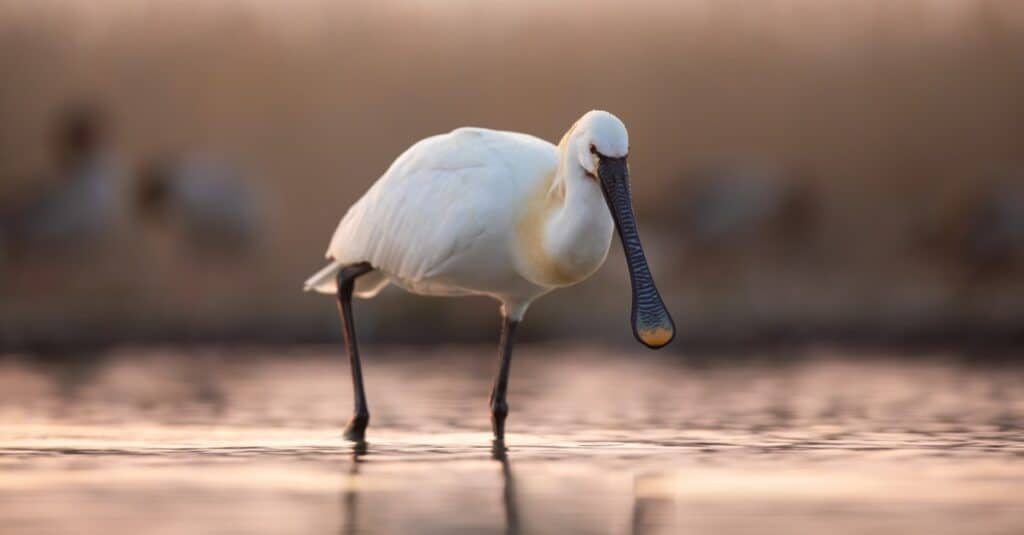
The Eurasian spoonbill swishes its beak through the water to find food.
©iStock.com/JMrocek
The Eurasian, or common spoonbill, Platalea leucorodia doesn’t use the long, unique bill that gave it its name to spear its food. Instead, it dips its bill in the water and swishes it around, thus taking up crustaceans, amphibians, insects, small fish, and fragments of plants.
The common spoonbill has a wide range that starts in Europe and stretches east to Korea and south to Iraq and Iran. It’s also found in North Africa. Its favorite habitat is shallow, muddy wetlands, and it matters not if the water is fresh, salty or brackish. The shape of the bill makes the bird unmistakable. The bill is black and yellow at the end. The bird’s legs are also black, but its plumage is white until the breeding season. Then, it develops a yellow patch on its breast and a crest. The common spoonbill is about 35 inches long, has a wingspan of between 3.8 and 4.4 feet and weighs between 2.49 and 4.32 pounds. The three subspecies are:
- P. leucorodia leucorodia
- P. leucorodia balsaci
- P. leucorodia archeri
The Eurasian spoonbill’s conservation status is least concern.
5.5 African Spoonbill
A cousin of the common spoonbill is the African spoonbill, P. alba. This bird also inhabits shallow wetlands, has the same type of diet as the common spoonbill and uses the same technique to catch prey. A plumage of a breeding African spoonbill is entirely white, while its face and legs are red. Its long spoon-like beak is gray. Like the common spoonbill, the African spoonbill’s conservation status is least concern.
6. Wood Stork
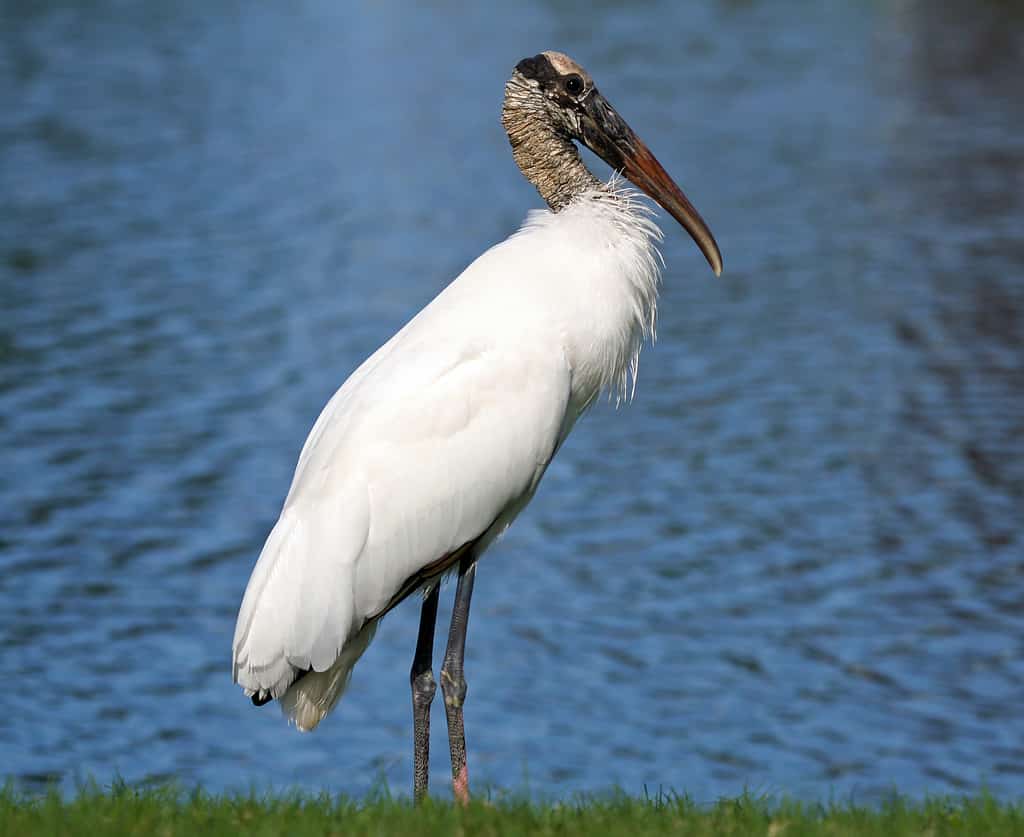
The wood stork prefers shallow, muddy bottomed bodies of water.
© Googie man at en.wikipedia / CC BY-SA 3.0 – Original / License
As its scientific name, Mycteria americana suggests, the wood stork is native to the Americas. It’s found from the coast North Carolina to as far south as Argentina. A wading bird, it prefers shallow, muddy wetlands in the tropics and subtropics.
The wood stork is about 3.3 to 3.75 feet high and has a wingspan of about 4.9 feet. Its long, sharp bill is black, and its head is charcoal gray and naked. The plumage is white save some of the wing and tail feathers, which are black and iridescent. The bird weighs about 5.8 pounds and both sexes look alike.
M. americana mostly eats fish and insects during the dry season. When the rainy season comes, it supplements the diet with crabs, frogs, snails, and other aquatic invertebrates. The bird prefers larger as opposed to smaller fish. It hunts by walking with its beak in the water and pumping its foot, maybe to stir up prey. When it finds prey, the bill automatically snaps shut on it. This happens so quickly that the human eye can’t detect it. Since sight isn’t important as touch for the wood stork, it sometimes hunts at night. This cuts down on competition with other wading birds such as herons. The wood stork’s conservation status is least concern.
7. Dalmatian Pelican

The Dalmatian
pelican
is the largest pelican in the world.
©Georgios Alexandris/Shutterstock.com
The Dalmatian pelican, Pelecanus crispus is the largest pelican in the world and maybe the largest bird that makes its living on bodies of fresh water. This bird can be 6 feet long, weigh between 16 and 33 pounds and have an 8-to-11-foot wingspan. Some scientists describe its plumage as silvery white as opposed to snowy white, and the plumage changes to a dingy grayish brown in winter. It also has curly fathers around its neck. When the bird flies, you can see the black tips of the wings.
Despite its huge size, the Dalmatian pelican is known for its graceful flight, and the awe-inspiring way a group flies in formation. The pelican is a wide ranging bird and is found from the Mediterranean to the Persian Gulf to Central Eurasia all the way to the Taiwan Strait. You’ll find this shorebird around rivers, lakes, and other types of wetlands.
Like other pelicans, P. crispus has a very long bill with a pouch. Its diet is almost exclusively fish, including carp, mullet, eels, and catfish. It finds prey by swimming, then submerging its head underwater so that its rear end sticks up. The fish is caught in the pelican’s bill, and when the bird re-emerges, it squeezes the water out of the pouch and swallows the fish. Pelicans have been known to hunt cooperatively.
Internationally, the Dalmatian pelican’s conservation status is near threatened due to poaching, habitat destruction, and climate change.
7.5 Great White Pelican
This pelican, found from southern Europe down into Africa and throughout Asia, is probably the second largest pelican in the world. P. onocrotalus ranges from 55 to 71 inches long with a 7-foot 5-inch to 11-foot 10-inch wingspan and a weight of between 20 and 33 pounds. One of the notable differences between the great white pelican and its cousin is that the males can be much larger than the females. The plumage of this bird is considered to be “whiter” than that of the Dalmatian pelican, though the primary and secondary feathers are black but hard to see when the bird is at rest. Another difference between the two pelicans is that the great white pelican’s conservation status is least concern.
Ibises
8. American White Ibis
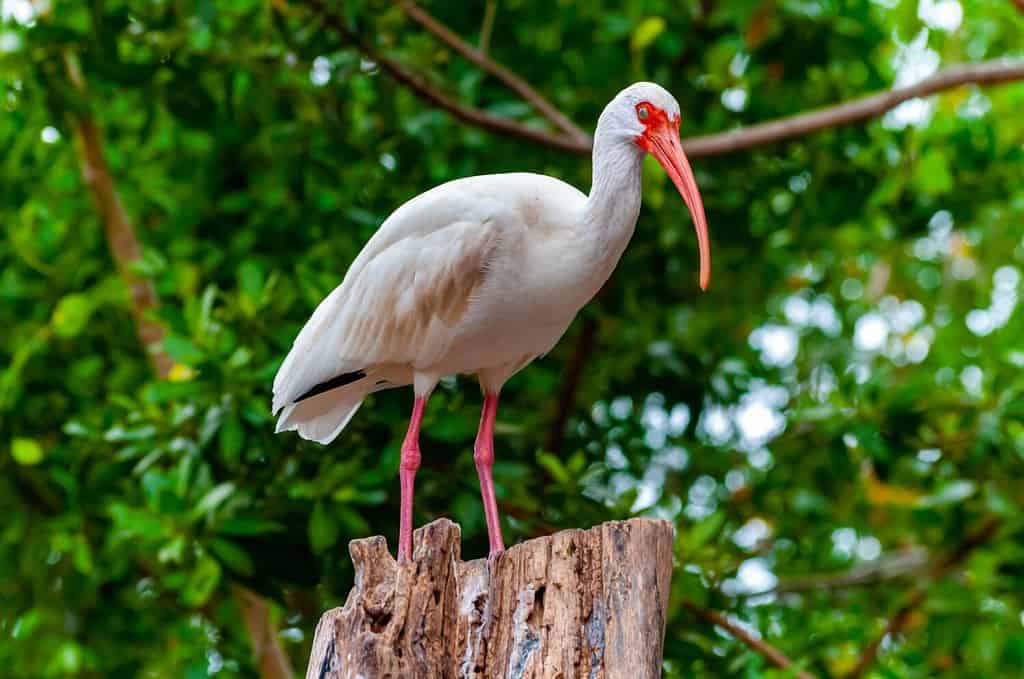
The American white ibis is another of the white birds with long beaks.
©Oleg Kovtun Hydrobio/Shutterstock.com
The wood stork was once known as the white ibis, but the two birds aren’t related. The American white ibis, Eudocimus albus is native to the coast of the United States from Virginia to Texas, down through Mexico and to northern South America. Its feathers are white, with black on the tips of the wings, and the bare face is pink. When the birds aren’t breeding, their beak and long legs are reddish orange. When they’re ready to breed, the bill grows shocking pink, and the legs turn magenta. Both sexes look alike, but the males are bigger and have longer beaks. The ibis can be told from an egret because its long, slender bill has a downward curve.
The bird is from 21 to 28 inches long, has a 35-to-41-inch wingspan and weighs a little over two pounds on average.
In North America, the American white ibis prefers crustaceans, including crayfish, but will also eat fish, frogs, and snails. It uses its long bill to probe for food in the muddy bottoms of the wetlands. Fish are usually too fast for the bird to snap up, but crustaceans generally are not. On the other hand, birds that live in South America prefer insects. The conservation status of the American white ibis is least concern. However, it is somewhat threatened by pollution.
8.5 Crested Ibis
Native to Japan, the eastern part of Russia and China, this white bird with a long bill is considered endangered. There are only about 330 birds, and they’re now found only in China’s Shaanxi Province. This ibis is about 31 inches long and lives in pine forests. Its head is partly naked, with bright red skin, and it has a crest on the back of its neck. Its scientific name is Nipponia nippon in tribute to its Japanese roots. It’s the only bird in its genus.
9. Black-Headed Ibis
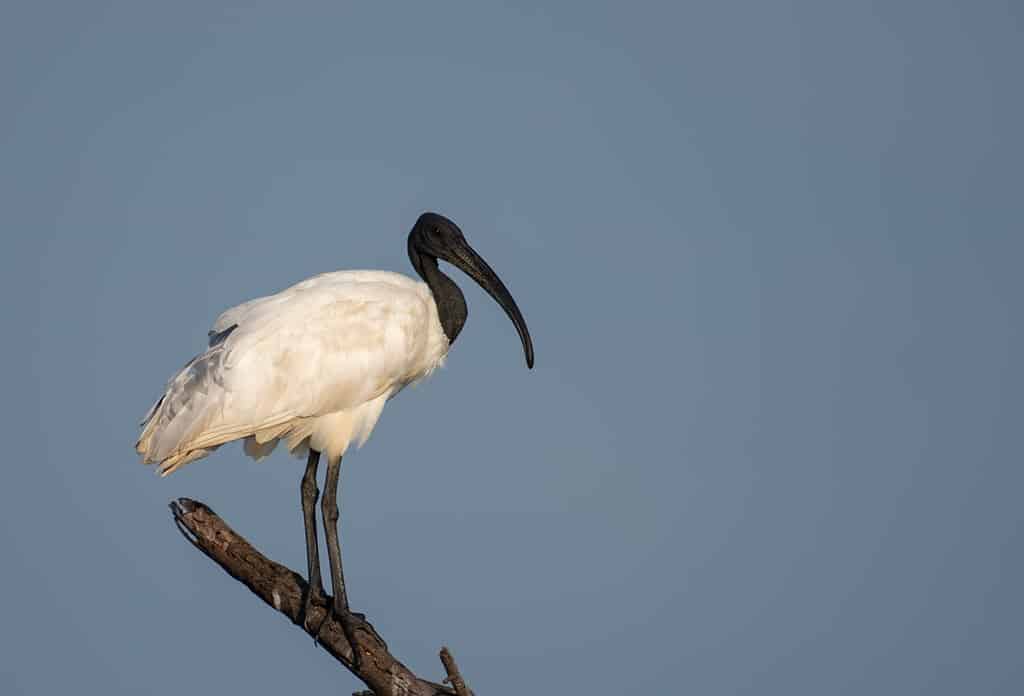
The black-headed ibis lives in a range of habitats, from rice paddies to open sewers.
©mihirjoshi/Shutterstock.com
Native to Asia from India to Japan, the scientific name of this bird is Threskiornis melanocephalus. It is distinctive because of its black head and legs and white feathers. During the non-breeding season there’s a dusting of gray on the tail feathers. When the bird takes on its breeding plumage, the feathers turn black. Patches of bare skin under the bird’s wing also turn red, and the heads of some birds take on a bluish sheen. The black-headed ibis is a medium sized bird that ranges between 2.13 to 2.46 feet long, and males and females look alike.
This ibis lives in a variety of habitats, including rice paddies, fresh and saltwater wetlands, ponds, lakes, even man-made lakes, irrigation ditches, and even garbage dumps and open sewers. The bird has a varied diet and will eat trash and carrion as well as the more usual ibis fare of fish, frogs and insects. The conservation status of the black-headed ibis is near threatened.
The photo featured at the top of this post is © Harry Collins Photography/Shutterstock.com
Thank you for reading! Have some feedback for us? Contact the AZ Animals editorial team.







